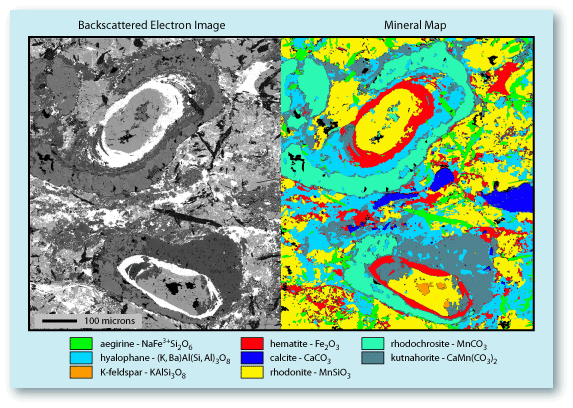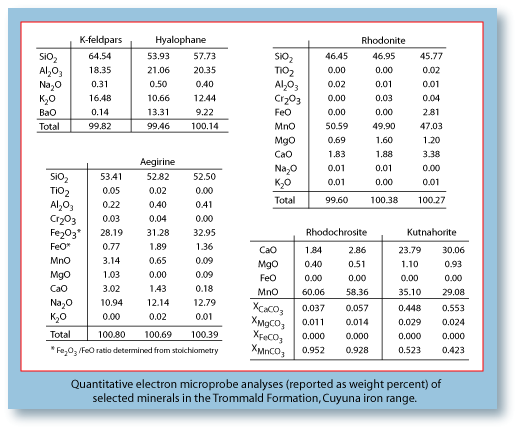| |
The upper feature has a core of mostly rhodonite, which is surrounded by hematite. That in turn is surrounded in succession by the Ba-feldspar, hyalophane, and then by the Mn-carbonate, rhodochrosite. The coatings of hyalophane have an enigmatic paragenesis, but must represent periods of barium, aluminum, and silica depositions on pre-existing grains. The fact that the hyalophane coating surrounds a hematite coating and is in turn surrounded by rhodochrosite, indicates that these phases or their precursors
were deposited from a very complex and changing aqueous
solution.
Below are quantitative electron microprobe analyses of
selected minerals shown in the previous images. The
hyalophane is a feldspar in which Ba has substituted for the
K. In the samples, the feldspars contain from trace amounts
of BaO to over 13 weight percent. The aegirine is a Na-rich
pyroxene. It occurs in many different textural settings in
these rocks and often occurs compositionally near its ideal
end-member, though there are some substitutions with
MnO and CaO. Rhodonite is a Mn-silicate, which in these
rocks contains up to a few percent FeO, MgO,
and CaO. There is a wide range of carbonates in these
rocks, most of which are low in Mg, and fall predominantly
within the ternary CaCO3- MnCO3- FeCO3. In the upper
member of the Trommald Formation, the carbonates are
mostly rhodochrosite, kutnahorite and Mn-rich calcite. |
|
In the middle and lower members, the carbonates are more
iron-rich and tend to be either manganiferous siderite or
ferroan kutnahorite.
The abundance of manganese oxides on the Cuyuna North
range has long proven to be an enigma. However, the occurrence of
aegirine and hyalophane in the iron-formation, as well as
associated barite and tourmaline within the stratigraphic
section, suggests that the protoliths of these rocks have a
significant exhalative hydrothermal component.
References:
McSwiggen, P.L., Morey, G.B., and Cleland, J.M, 1994a, The origin of aegirine
in iron-formation of the Cuyuna Range, east-central Minnesota: Canadian
Mineralogist, v. 32, p589-598.
________ 1994b, Occurrence and genetic implications of hyalophane in
manganese-rich iron-formation, Cuyuna iron range, Minnesota, USA:
Mineralogical Magazine, v. 58, p. 387-399.
________ 1995, Iron-formation protolith and genesis, Cuyuna Range,
Minnesota: Minnesota Geological Survey Report of Investigation 45, 54p. |










